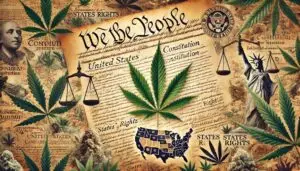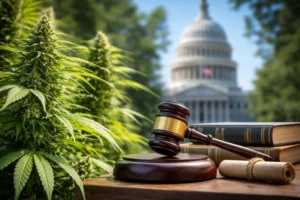Fifth Circuit Court Ruling on Second Amendment and Marijuana Use: A Landmark Case
The Fifth Circuit Court of Appeals recently handed down a significant decision in United States v. Paola Connelly, a case that has major implications for the intersection of drug use and Second Amendment rights. This case delves into the constitutional challenges against laws that restrict firearm possession by individuals who use controlled substances, particularly marijuana, which remains illegal under federal law despite cannabis being decriminalized or legalized in various states.
Case Background: A Clash of Rights and Regulations
In December 2021, El Paso police responded to a “shots fired” call at Paola Connelly’s home. Upon arrival, officers encountered Connelly’s husband, John, who was firing a shotgun at a neighbor’s door. After his arrest, a sweep of the Connelly home revealed drug paraphernalia and several firearms. Paola admitted to occasionally using marijuana to aid sleep and manage anxiety. This led to her being charged under 18 U.S.C. § 922(g)(3) for possessing firearms as an unlawful user of a controlled substance, and under 18 U.S.C. § 922(d)(3) for providing firearms to an unlawful user.
The Legal Battle: Second Amendment vs. Federal Gun Laws

The government appealed, bringing the case to the Fifth Circuit, which had to consider whether the application of these laws to Connelly was consistent with the historical understanding of the right to bear arms.
The Fifth Circuit’s Ruling: A Mixed Verdict
The Fifth Circuit issued a nuanced ruling. The court affirmed that 18 U.S.C. § 922(g)(3) was unconstitutional as applied to Paola Connelly, recognizing that while the government can restrict firearm possession for those who are actively under the influence, it cannot extend this prohibition to individuals who are sober and only occasionally use substances like marijuana. The court emphasized that the historical tradition of firearm regulation does not support disarming sober individuals based solely on past drug use.
However, the court did not strike down the law entirely. It reversed the District Court’s ruling on the facial challenge, stating that there are indeed scenarios where the law could be constitutionally applied—specifically, in cases where a person is actively intoxicated while possessing a firearm.
Implications of the Ruling
This ruling underscores the ongoing tension between federal firearms laws and the evolving landscape of state-level drug legalization. It also highlights the judiciary’s role in balancing individual rights against public safety concerns. For marijuana users who own firearms, this decision is particularly significant. It suggests that while occasional, non-impairing use of marijuana might not strip away Second Amendment rights, the context and timing of drug use in relation to firearm possession remain critical factors.
Moreover, this case could pave the way for further challenges to federal firearm prohibitions, especially as societal norms around substance use continue to shift. As more states legalize marijuana, and as the legal system grapples with these changes, we may see more cases like United States v. Paola Connelly influencing the interpretation and application of the Second Amendment.
Conclusion
The Fifth Circuit’s ruling in United States v. Paola Connelly marks a pivotal moment in the ongoing dialogue about gun rights and drug use in America. By affirming Connelly’s as-applied challenge, the court has signaled that the Second Amendment protections cannot be overridden lightly, especially when the individual in question is not actively under the influence of a controlled substance. However, the court also maintained that certain applications of 18 U.S.C. § 922(g)(3) and § 922(d)(3) remain valid, keeping the door open for these laws to be enforced in specific circumstances.
As this legal landscape continues to evolve, it will be crucial for gun owners, lawmakers, and legal professionals to stay informed about how these developments might affect the intersection of drug use and the right to bear arms.




